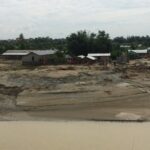Nepal’s fiscal budget for 2021/2022 is targeted towards tackling problems faced due to COVID-19 with priorities in uplifting economic activities, increasing job and employment opportunities, ensuring efficient agricultural productivity, and providing investment opportunities in infrastructure development. The Nepal Rastra Bank (NRB) published the monetary policy for the fiscal year 2021/2022 keeping in view the budget with the aim to achieve macroeconomic stability and contribute towards the economic recovery of the country.
The monetary policy for 2021/2022 had prioritized refinancing activities by increasing the credit-deposit ratio to 90%, providing an additional 5% liquidity for lending purposes, and reducing the core capital plus deposit (CCD) ratio to 80%. Additionally, there was a reduction in the cash-reserve ratio (CRR) by 0.5% and statutory liquidity ratio (SLR) by 1% for one-year after the commencement of joint operations. This was done to encourage mergers and acquisitions in the Banking and Financial Institutions (BFIs) sector. A provision of an additional 1% interest on remittance deposits was also introduced to increase remittance inflow in Nepal through formal banking channels.
Furthermore, the monetary policy aimed at controlling the significant players in the share market by implementing margin lending restrictions, where a person or entity can only take margin loans of NPR 40 million from each financial institution with an upper limit of NPR 120 million in total. Keeping in mind the COVID-19 pandemic’s reverberating effects on the economy, the monetary policy extended the loan payment timeframe to an additional one-year, allowing the institutions to pay in four installments. Therefore, flexible loan and borrowing facilities were implemented to ensure more liquidity in the market to recover from the pandemic.
The primary concern in the first quarter of FY 2021/22 has been the liquidity crunch that the domestic banking system has been facing. There have been shortages of loanable funds because commercial banks have been providing loans at decreased rates in ordinance with the monetary policy introduced to tackle the effects of the pandemic.
According to the review of the monetary policy, loans from banks and financial institutions (BFIs) have increased by 7.7% compared to a 4% increase in the corresponding period last year. There has been a 74.7% increase in the overall production and turnover in the first quarter of 2021/2022 compared to 50.5% growth in the same period last year. The huge rise in loans and advances to customers has resulted in increasing investments in the economy but has also caused a liquidity crunch in the market. Since the credit growth trajectory has been higher than that of deposit growth, the liquidity crunch might rise further.
Moreover, the balance of payments (BOP) deficit and declining remittance inflow have been at the forefront of this problem. Therefore, the review states that a cash margin should be maintained while issuing the letter of credit for the import of specified items. This has been done keeping in mind the existing situation of foreign exchange reserves in the country. In addition, interest rates and fees for foreign currency loans will be reviewed under the arrangements made. This will be done to ensure the collection of foreign currency deposits from non-resident Nepalis and foreign institutions which includes non-resident Nepalis. The existing limit on non-deliverable forward trading of foreign currency is expected to be reviewed as well.
The other key highlights of the review of the monetary policy, which was released in November 2021 are as follows:
- The annual inflation which was expected to increase by 18% has already reached 17.9% in the first quarter of 2021/2022.
- The mandatory cash reserve ratio (CRR) and statutory liquidity ratio (SLR) has not been changed by the government. The cash-deposit ratio, which had a cap of 90%, also remains unchanged.
- Arrangements will be made for banks to issue guarantees to Nepali firms in the agricultural, manufacturing, infrastructure, and tourism sectors which require institutional loans from foreign institutions.
- Loans will be provided for the construction of hospitals in local areas with poor health facilities. Arrangements will be made for the construction of a 100-bed hospital in these areas with a provision of loans up to NPR 20 crores with a 2-percentage point premium to the base rate.
Conclusion
A new directive regarding interest rates to make imports and borrowings more expensive and encourage deposit mobilization, was highly anticipated before the review of the monetary policy was released. However, this did not happen and NRB did not address the 4/12 share loan structure.
While the review did not contain any negative changes for the investors, the highly anticipated changes were disregarded, hence causing sentiments to remain bearish in the secondary market. The Nepal Rastra Bank (NRB) is still expected to provide refinance facilities and implement interest subsidy concessional lending programs for severely affected sectors to help mitigate many of the problems related to liquidity. The NRB has urged the government to impose restrictions on the import of luxury goods in the country due to the surging balance of payment deficits which have resulted in fast-decreasing foreign exchange reserves. Quantitative limits and high customs duty are seen as key measures that can be taken to narrow the gap in the balance of payment deficits.
Remittance inflows, which are usually higher during the festive periods, also fell by 7.6% during this period. Therefore, despite a lot of foreign currency being spent on imports, Nepal hasn’t seen a significant inflow of foreign currency. While it is important to keep a check on the interest rates and loan provisions in Nepal, it is imperative to look at the cost-push inflation caused by supply issues in the country. Surging vegetable prices due to sudden rainfall and crop damages and high oil prices due to the rise in international petroleum prices have induced cost-push inflation. Therefore, there is a need to strike a balance between interest rates, remittance inflows, loans, and imports in the country to ensure that the inflation can be controlled, and the balance of payment deficits can be narrowed down.
Mohit Lal Shrestha is a B.A. Honors in Liberal Arts and Humanities (Economics) from O. P. Jindal Global University, Sonipat. He has also completed a Post Graduate Diploma in Research and Innovation in Finance from the same university. His key interests lie in corporate finance, business valuation, financial modeling, and development economics. Before joining beed, Mohit has worked in banking and investment management organizations. He is currently working as a beedtern at beed management.





